Pahonia
The Pahonia[1][2][3] (Belarusian: Паго́ня, transliteration: Pahonia, Belarusian pronunciation: [paˈɣonʲa]; Polish: Pogoń, – literally: "Pursue"; Lithuanian: Vytis – literally "to chase") is the historical coat of arms of the Grand Duchy of Lithuania, one variation of which is the current coat of arms of Lithuania. It was also the official emblem of the Belarusian Democratic Republic in 1918 and of the Republic of Belarus from 1991 to 1995.
| Pahonia | |
|---|---|
.svg.png) | |
| Versions | |
 | |
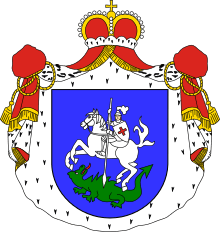 | |
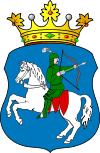 Pogon Tatar | |
| Earlier version(s) | 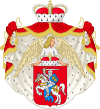 Grand Duchy of Lithuania |
| Use | Belarus (1991–1995) Belarusian Democratic Republic (1918) |
On May 14, 2007 the Pahonia was declared cultural heritage of Belarus.[4]
History
Grand Duchy of Lithuania
The charging knight first emerged as a state emblem in the region in 1329 on the seal of duke Alexander Michailovich of Pskov.[5] He was the deputy of Gediminas of Lithuania to Pskov which was a part of Grand Duchy of Lithuania at that time. At the same time duke Narimantas of Polotsk used Pahonia on his seal as well.[6] These facts illustrate that it is the most probable that Pahonia was already in use as a state symbol of Lithuania at least in 1329. However, by Gustyn Chronicle duke Vytenis of Lithuania (1293–1316) "began ruling on Lithuania and designed a coat of arms and a seal for himself and for Lithuania: armed knight riding on a horse; this symbol at present time is called Pahonia" (quote by "Chronicles about Pahonia's birth").
The symbol of the charging knight on horseback passed down through the generations: from Algirdas to his son, Grand Duke Jogaila (ruled 1377 – 1392), then to Grand Duke Vytautas (ruled 1392 – 1430) and to others. By the 14th century, the charging knight on horseback with a sword had begun to feature in an heraldic shield, first in Jogaila's's seal in 1386 or 1387, and also in the seal of Vytautas in 1401. As early as the 15th century, the heraldic charging knight on horseback became the coat of arms of the Grand Duchy of Lithuania and of its central part – the Duchy of Vilnius. 16th-century documents refer to it using the Polish term Pogoń. At first, the charging knight might appear riding either left or right; and sometimes he held a lance. But as of the first half of the 15th century, all depictions show him riding towards the left (as seen by the viewer), with a sword in his raised hand and a shield in the left hand.
_cut.png) Coat of arms in 1575
Coat of arms in 1575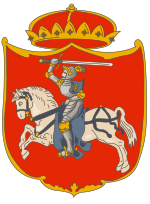 An appearance of the coat of arms in the 16th century
An appearance of the coat of arms in the 16th century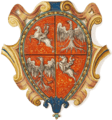 Coat of arms of the Polish-Lithuanian Commonwealth
Coat of arms of the Polish-Lithuanian Commonwealth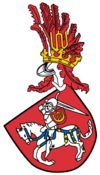 Coat of arms of Lithuania redrawn from the 15th century Codex Bergshammar
Coat of arms of Lithuania redrawn from the 15th century Codex Bergshammar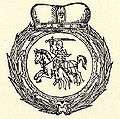 The Pahonia as depicted on the Statute of the Grand Duchy of Lithuania, 1588
The Pahonia as depicted on the Statute of the Grand Duchy of Lithuania, 1588
In the 15th century, the colors of the seal became uniform. The livery colors became fixed: a white (silver) charging knight on a red field of the heraldic shield. The charging knight at this time bore a blue shield, and set against the blue field appeared a double (gold) cross. The coat of arms featured the Grand Duke's headgear on the crest.
At first, the charging knight showed the figure of the ruler of the country, but with time it came to be understood and interpreted as that of a riding knight chasing an intruder out of his native country. Such an understanding became especially popular in the 19th century and in the first half of the 20th century. The explanation has a sound historical foundation. We know that at the Battle of Grunwald (1410), where the united Polish-Lithuanian army crushed the army of the Teutonic Knights (thus putting an end to the Knights' eastward expansion) thirty Lithuanian and Ruthenian regiments out of a total of forty fought under banners flying the sign of the Pahonia.
With minor stylistic changes, the Pahonia coat of arms remained the state symbol of the Grand Duchy of Lithuania until 1795, when the Russian Empire annexed and extinguished the Polish-Lithuanian Commonwealth in the Third Partition of Poland.
19th Century

_(1845).png)
Following the partition of the Polish-Lithuanian Commonwealth, most of the Grand Duchy of Lithuania was absorbed by the Russian Empire and the Pahonia was incorporated into the imperial state emblem. After the first partition of Poland and Lithuania, Catherine the Great gave the Pahonia coat of arms to several towns in the newly acquired ethnic Belarusian and Latgallian territories, including Daugavpils, Ludza, Sebezh, Polacak, Nevel, Haradok, Viciebsk, Surazh, Velizh. The motive for this was that this territory once belonged to the Grand Duchy of Lithuania.
.jpg)
The Pahonia was the coat of arms of the Vilna Governorate following the incorporation of Vilnius and surrounding lands into the Russian Empire. Pahonia statues placed on white columns greeted visitors at the entrances to the city from 1818 until 1840, when the statues were replaced with two-headed eagles – the state symbol of the Russian Empire.
Uprisings to restore the Polish-Lithuanian Commonwealth like the 1830–31 November Uprising and 1863–64 January Uprising saw the Pahonia used as a symbol of rebellion against the Russian Empire.
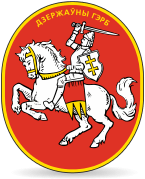
During the 19th century Lithuanian National Revival, Simonas Daukantas introduced the term wytis in reference to the Pahonia for the first time in an historical work on Lithuanian culture called Budą Senowęs Lietuwiû kalneniu ir Żemaitiû (1846). The etymology of this particular name is not universally accepted; it is either a direct translation of the Polish Pogoń, a common noun constructed from the Lithuanian verb vyti ("to chase") or, less likely, a derivative from the East Slavic title of the knight, vytiaz'. The earliest known Lithuanian name for the symbol is a 17th-century translation of Pogonia by Konstantinas Sirvydas as Waikimas ("Vaikymas", according to contemporary Lithuanian spelling), which was used until the 19th century together with Pagaunia (in Lithuanian, "pagauti" means "to catch").[7]
1918–1990
The Pahonia appeared on the state seal of the Belarusian Democratic Republic for a short period between 1918 and 1919. West Belarus became part of interwar Poland, and the Pahonia was used as the symbol of several provinces which had sizeable Belarusian minorities, namely the Polesie Voivodeship, the Wilno Voivodeship, and the Nowogródek Voivodeship. It was also used by West Belarusian separatist organizations.
It was the national coat of arms of the independent Republic of Lithuania (1918–1940) until the country was forcibly annexed by the Soviet Union in 1940. During the Second World War, the Belarusian Central Rada and the Provisional Government of Lithuania, both Nazi puppet régimes, also used the symbol.
During Soviet times the use of the emblem was illegal. It was used only by Belarusian and Lithuanian emigre communities in the USA, Canada, and elsewhere.
.jpg) Passport of the Belarusian Democratic Republic, 1918-1919
Passport of the Belarusian Democratic Republic, 1918-1919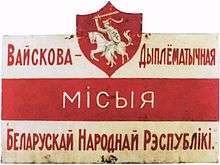 Sign of a Belarusian diplomatic mission in late 1910s - early 1920s
Sign of a Belarusian diplomatic mission in late 1910s - early 1920s.jpg) Flag of the 1st Slutsk Regiment during the Slutsk Defence Action, 1920
Flag of the 1st Slutsk Regiment during the Slutsk Defence Action, 1920 Juozas Zikaras' design, used on coins of the interwar Republic of Lithuania
Juozas Zikaras' design, used on coins of the interwar Republic of Lithuania.png) Interwar Republic of Lithuania
Interwar Republic of Lithuania
.svg.png)
1990–present
In the late 1980s, during a new wave of Belarusian national rebirth, the Belarusian Popular Front adopted the Pahonia as its emblem, despite the fact that its public display constituted a criminal offense in the Soviet Union. Variants were used by Lithuania's independence movement during the perestroika period. Its use was legalised by Lithuania's Soviet authorities in 1988.
On 11 March 1990, Lithuania declared independence from the Soviet Union and restored all of its pre-World War II state symbols, including the historic coat of arms. On September 4, 1991, a new design by Arvydas Každailis was approved based on recommendations of a special heraldic committee. The new design replaced interwar versions, harkening back to earlier variants used by the Grand Duchy of Lithuania. It re-established its original colors but placed the horse and rider in an ostensibly more "defensive" posture, airs above the ground rather than leaping forward and sword simply elevated rather than ready to strike.
.jpg)
In 1991, after the dissolution of the Soviet Union, the Pahonia became the coat of arms of the independent Republic of Belarus. The official design of the 1991 coat of arms of Belarus was created by a team of artists led by Jauhien Kulik and Uladzimir Krukouski basing on various Medieval designs of the Pahonia as the coat of arms of the Grand Duchy of Lithuania.[8][9]
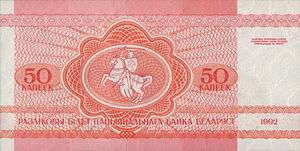
.jpg) Belarusian passport, 1991-1995
Belarusian passport, 1991-1995 Constitution of Belarus, 1994
Constitution of Belarus, 1994 "Airs above the ground": the contemporary, "defensive" coat of arms of the Republic of Lithuania by Arvydas Každailis (official since 1991)
"Airs above the ground": the contemporary, "defensive" coat of arms of the Republic of Lithuania by Arvydas Každailis (official since 1991)
In 1995, following a controversial referendum, Alexander Lukashenko scrapped the Pahonia's status as the official coat of arms and replaced it with a modified Soviet emblem. Since then the Pahonia has served as one of the symbols of the anti-Lukashenko opposition in Belarus.
In 2004, Lithuania's Seimas confirmed an historical flag of Lithuania depicting the Pahonia on a rectangular red background, recalling the old battle flags of the Grand Duchy of Lithuania. The flag does not replace the yellow-green-red tri-color national flag of Lithuania. It is used on special occasions and buildings of historic significance.
It is currently proposed that a larger version of the coat of arms be adopted. It would feature a line from "Tautiška giesmė", the national anthem of Lithuania, "Vienybė težydi" ("May unity blossom"). The Seimas already uses a larger version of the coat of arms with this phrase as its motto, along with two supporters: the dexter one a griffin argent beaked and membered or, langued gules, and the sinister one a unicorn argent, armed and unguled or, langued gules, and the ducal hat on top of the shield. The President of Lithuania uses the shield and supporters only.
Lithuania joined the Eurozone by adopting the euro on 1 January 2015.[10] The designs of Lithuanian euro coins share a similar national side for all denominations, featuring the Vytis and the name of the country, "Lietuva". The design was announced on 11 November 2004 following a public opinion poll conducted by the Bank of Lithuania. The horse is again leaping forward, as in more traditional versions.
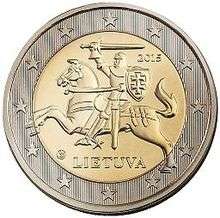 Lithuanian euro coin, obverse side
Lithuanian euro coin, obverse side.svg.png) The historical state flag of Lithuania, official since 2004
The historical state flag of Lithuania, official since 2004
Pahonia as a regional coat of arms
The Pahonia is a feature of many emblems of cities and provinces of the former Grand Duchy of Lithuania and Polish-Lithuanian Commonwealth.[11]

 Vilnius/Wilno Voivodeship (annexed by Poland from 1926–1939)
Vilnius/Wilno Voivodeship (annexed by Poland from 1926–1939)
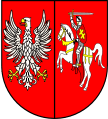
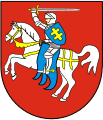
 Polock Voivodeship
Polock Voivodeship Witebsk Voivodeship
Witebsk Voivodeship Banner of the Mstsislaw Voivodeship
Banner of the Mstsislaw Voivodeship
After the annexation of the Grand Duchy of Lithuania to the Russian Empire, the Vitebsk and Vilno governorates inherited coats of arms of their former voivodeships.
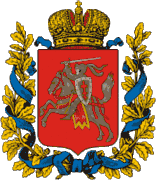 Vilna Governorate coat of arms
Vilna Governorate coat of arms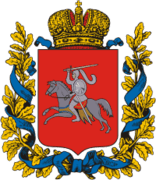 Vitebsk Governorate coat of arms
Vitebsk Governorate coat of arms
Pahonia is the official emblem of the Vitsebsk voblast and part of the official emblem of the Homyel voblast.
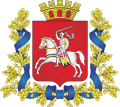 Vitsebsk voblast coat of arms
Vitsebsk voblast coat of arms Homyel voblast coat of arms
Homyel voblast coat of arms
Pahonia (Vytis) is the official emblem of Vilnius County and Panevėžys County in modern Lithuania.
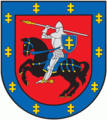 Vilnius County coat of arms
Vilnius County coat of arms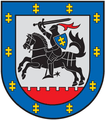 Panevėžys County coat of arms
Panevėžys County coat of arms
Appearances on urban coats of arms
While being part of the Grand Duchy of Lithuania, some towns in Lithuania, Poland, Russia, Ukraine, Belarus (notably Vitebsk, Haradok, Polotsk and others) adopted the Pahonia as part of their coats of arms. Some of them continue usage of the coats today:
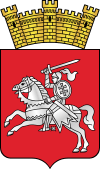
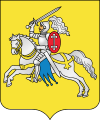
_(1845).png) Vileyka (former coat of arms from 1845)
Vileyka (former coat of arms from 1845)_(1845).png) Lida (former coat of arms from 1845)
Lida (former coat of arms from 1845).png) Nevel, today part of Pskov Oblast of Russia
Nevel, today part of Pskov Oblast of Russia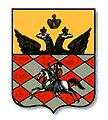 Velizh, today part of Smolensk Oblast of Russia
Velizh, today part of Smolensk Oblast of Russia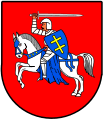
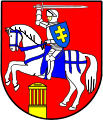
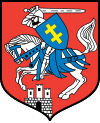 Siedlce, in Poland
Siedlce, in Poland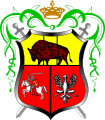 Drohiczyn, in Poland
Drohiczyn, in Poland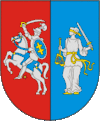 Liudvinavas, in Lithuania
Liudvinavas, in Lithuania
Rechytsa, Mahiloŭ and several other cities have historically had the Pahonia as part of their city coat of arms:
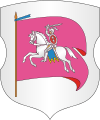

 Lipnishki
Lipnishki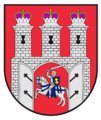
Pahonia as a political symbol
Pahonia/Pogoń has been used by several political movements on the territory of the former Grand Duchy of Lithuania and in present-day Belarus
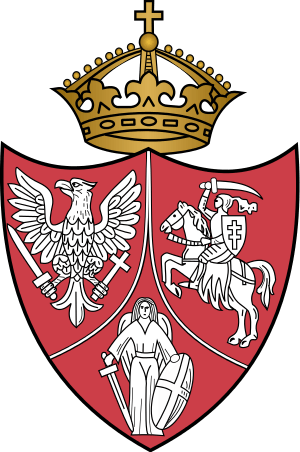 Emblem of the January Uprising
Emblem of the January Uprising
Other usage
Pahonia is part of the emblems of several organizations in Belarus, including the World Association of Belarusians, the Frantsishak Skaryna Belarusian Language Society, the Union of Poles of Belarus as well as the BelaPAN news agency.[12]
Design and variations
Belarus (Pahonia)
The heraldic shield features a red field with an armored knight on a white (silver) horse holding a silver sword in his right hand above his head. A silver shield hangs on the left shoulder of the charging knight, and a golden (yellow) Patriarchal cross appears on the shield.
Ukrainian People's Republic

The rider carries a shield with the golden lion.
Lithuania (Vytis)

The main variation is a shield with the Jagiellonian dynasty coat of arms. The rider with Jagiellonian cross was popular in the Polish–Lithuanian Commonwealth and adopted for many of its voivodeships.
Gules, a knight armed cap-à-pie mounted on a horse salient argent, brandishing a sword proper and maintaining a shield azure charged with a cross of Lorraine Or.
Ostrogski family

Sometimes the rider may carry no shield at all.
Other variations
 Minor Pogon
Minor Pogon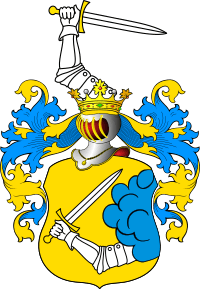 Pogon Polska (Pogonia)
Pogon Polska (Pogonia) Pogon Tatar
Pogon Tatar
- Pogoń Litewska coat of arms
- Pogoń Ruska coat of arms
References
- James B. Minahan. The Complete Guide to National Symbols and Emblems [2 volumes]. ABC-CLIO, 2009. P. 329, 332, 970.
- Astapienia R. The history of the Great Duchy of Lithuania: Belarus' Medieval Origins // The Journal of Belarusian Studies. 2014. P. 108.
- Łatyszonek O. My ranking of European nations it the early 21st century // The Geopolitical Place of Belarus in Europe and the World. Fundacja Przestrzeni Obywat, 2006. P. 167
- Пастанова Савета Міністраў Рэспублікі Беларусь 14 мая 2007 г. № 578 «Аб статусе гісторыка-культурных каштоўнасцей»
- About a question of aspects of the foundation of Great Duchy of Lithuania (second part) Archived February 2, 2014, at the Wayback Machine
- Chronicles about Pahonia's birth
- Lietuviškoje XVIIIa. pabaigos – XIXa. literatūroje valstybės herbas, galima sakyti, vadintas tik Vaikymu, kuris neabejotinai yra lenkiškojo Pogonia atitikmuo
- http://www.svaboda.org/content/article/26949275.html
- http://euroradio.fm/yak-stvarali-gerb-pagonya-fota
- http://www.consilium.europa.eu/en/splash/?requested=%2fhomepage%2fhighlights%2flithuania-adopts-the-euro%2f%3flang%3den
- [https://www.webcitation.org/query?url=http://www.geocities.com/heraldica_litvaniae/regijony/vajvodships.html&date=2009-10-25+23:55:45
- http://belapan.com
External links

- The comparison of symbols of Lithuania and the Muscovite Ruthenia (in Russian)
- National Symbols In Belarus: The Past And Present
